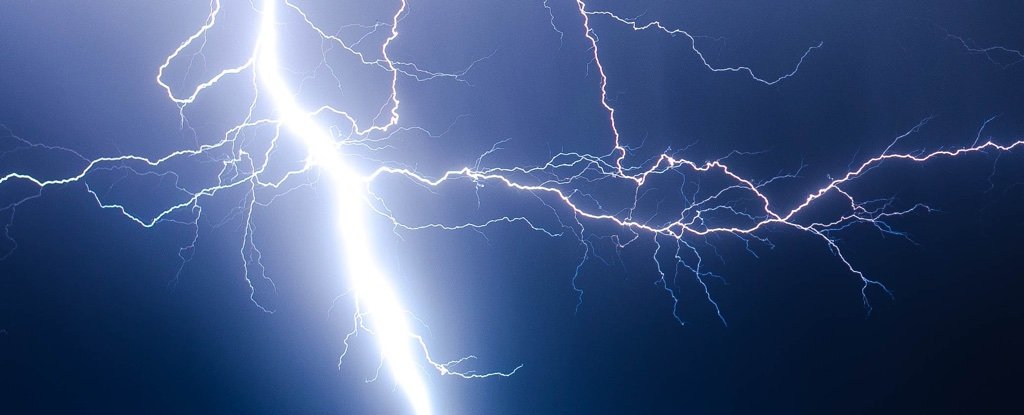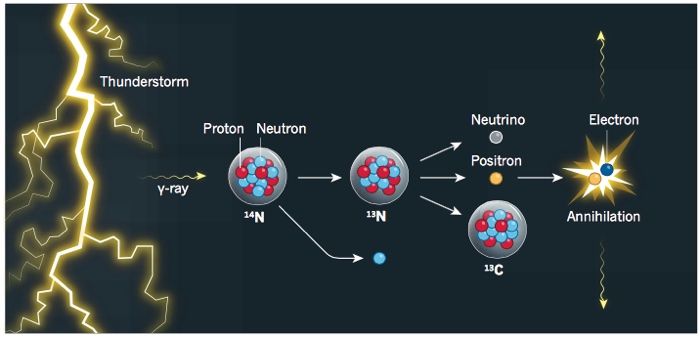Het is een bevestiging van een 100 jaar oude hypothese

(Brandon Morgan/Unsplash)
Het is al heel lang voorspelt dat hoge energie electronen in bliksem gammastralen kunnen produceren, die nucleaire reacties in onweerswolken kunnen teweeg brengen. Nu is het dan ook daadwerkelijk geobserveerd door wetenschappers.
Het artikel zie hieronder:
Breaking: Thunderstorms Observed Triggering Nuclear Reactions in The Sky
PETER DOCKRILL22 NOV 2017
For the first time, scientists have witnessed lightning triggering nuclear reactions in the atmosphere, confirming a hypothesis dating back almost a century.
It's long been predicted that high-energy electrons in lightning can produce gamma rays that induce nuclear reactions in thunderclouds, but before now, the phenomenon has never been conclusively observed.
"The photonuclear reaction in the atmosphere has been theoretically expected [to be] triggered by such high energy radiation," one of the researchers, astrophysicist Teruaki Enoto from Kyoto University in Japan, explained to ScienceAlert.
"Several groups have accumulated signatures of this phenomena, such as signals of either neutrons or positrons, which are the products of this reaction."

(Leonid Babich/Nature)
Since the 1980s, scientists have detected these kinds of signals using ground-based observatories, aircraft, and satellites, but before now it was difficult to confirm experimentally that nuclear reactions were yielding the neutrons, positrons, or particles observed.
Here, Enoto and fellow researchers made use of radiation detectors installed at the Kashiwazaki-Kariwa nuclear power station in Niigata, along the coast of the Sea of Japan.
During a thunderstorm in February this year, the team detected "intense radiation" from lightning strikes just off the coast, including a brief gamma ray flash.
This was followed by a prolonged gamma ray line at an energy of 0.511 megaelectronvolts (MeV) – the energy signature you'd expect to see from positrons and electrons after a nuclear reaction.
"This line is a conclusive indication of electron–positron annihilation, and represents unequivocal evidence that photonuclear reactions can be triggered by thunderstorms," explains experimental physicist Leonid Babich from the Russian Federal Nuclear Centre, in a commentary on the research in Nature.
According to Enoto, the findings show us there's more going on in thunderstorms than we may tend to imagine.
"Usually people think lightning can interact with electrons in atoms," he told ScienceAlert.
"The photonuclear reactions indicate that lightning also interacts even with nuclei if gamma rays have sufficiently high energy to knock out neutrons from the nuclei."
In addition to generating neutrons and positrons, the process observed is also important because it's only the second time we've seen radioactive isotopes being naturally produced in the atmosphere – with the other example being particles produced by cosmic rays.
But just because there's now firm evidence that lightning is generating radioactive particles in the sky, there's no reason to be concerned.
"Since the radioactive isotopes are short-lived, spatially restricted, and [comprise a] relatively small amount compared to usual background radiative environments, I think there is no health risk from this phenomena," Enoto says.
As to whether this means all thunderstorms are capable of kickstarting these reactions, the researchers aren't entirely sure.
"This is still an open question," Enoto says.
"We have proved the existence of photonuclear reactions at least from one lightning discharge… in order to answer your question, we need more statistical and quantitative studies. I am personally suspecting that the photonuclear reaction would happen at powerful events."
The findings are reported in Nature.
Bron: http://www.sciencealert.com/thunderstorms-observed-triggering-nuclear-reactions-in-the-sky-lightning-gamma

 Wetenschappers observeren bliksem die een nucleaire reactie triggert
Wetenschappers observeren bliksem die een nucleaire reactie triggert




